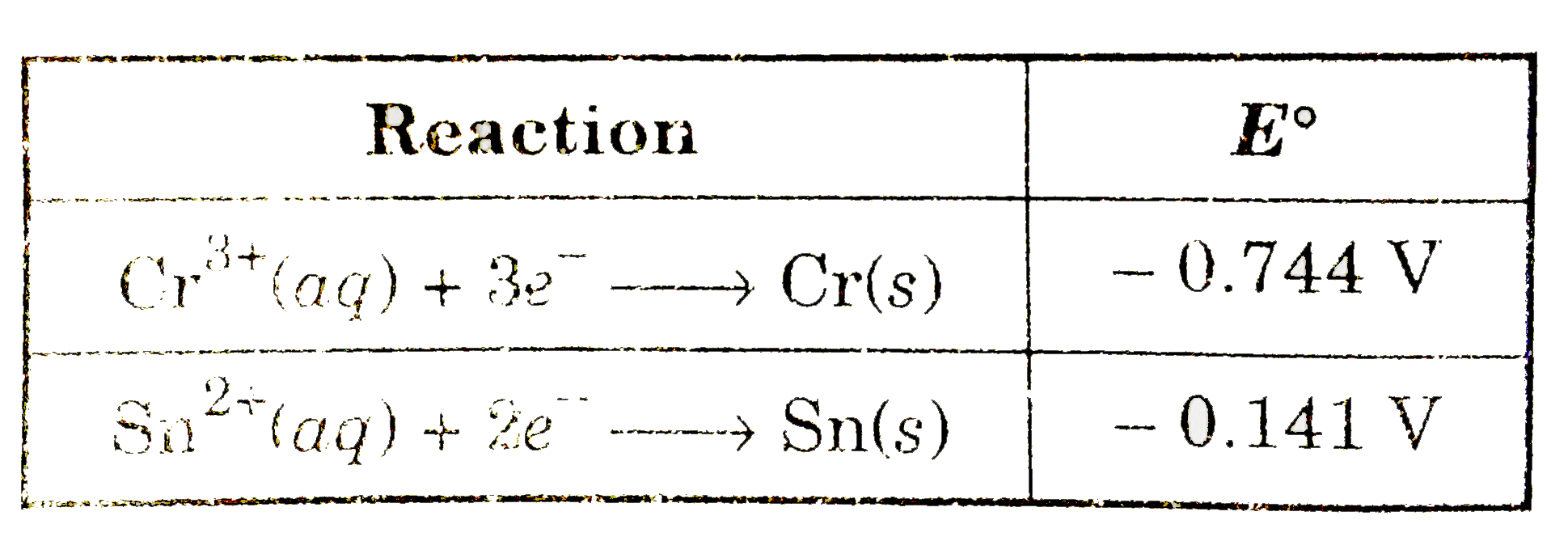Sn4+(aq)+2e−→Sn2+(aq) E∘=0.15V
Cr3+(aq)+e−→Cr2+(aq) E∘=0.41V
According to the standard reduction potentials above, what is the value of E∘ for the reaction below?
2Cr3+(aq)+Sn2+(aq)→2Cr2+(aq)+Sn4+(aq)
−0.97V
−0.56V
+0.56V
+0.97V
The correct Answer is:B
Step by step video, text & image solution for Sn^(4+)(aq) + 2e^(-) rightarrow Sn^(2+)(aq) E^(@) = 0.15V Cr^(3+)(aq) + e^(-) rightarrow Cr^(2+)(aq) E^(@) = 0.41V According to the standard reduction potentials above, what is the value of E^(@) for the reaction below? 2Cr^(3+)(aq) + Sn^(2+)(aq) rightarrow 2Cr^(2+)(aq) + Sn^(4+)(aq) by Chemistry experts to help you in doubts & scoring excellent marks in Class 12 exams.
Updated on:21/07/2023Topper's Solved these Questions
- ELECTROCHEMISTYBOOK - GRB PUBLICATIONCHAPTER - ELECTROCHEMISTYEXERCISE - Latimer Diagram, concentration cells
117 Videos
- ELECTROCHEMISTYBOOK - GRB PUBLICATIONCHAPTER - ELECTROCHEMISTYEXERCISE - Batteries
10 Videos
- ELECTROCHEMISTYBOOK - GRB PUBLICATIONCHAPTER - ELECTROCHEMISTYEXERCISE - Subjective type
39 Videos
- D-BLOCK ELEMENTSBOOK - GRB PUBLICATIONCHAPTER - D-BLOCK ELEMENTSEXERCISE - Subjective Type
18 Videos
- ENVIRONMENTAL CHEMISTRY BOOK - GRB PUBLICATIONCHAPTER - ENVIRONMENTAL CHEMISTRY EXERCISE - Straight objective type
40 Videos
Similar Questions
Agaq+e−→Ag(s) E69∘)=0.80V
Mg2+(aq)+2e−→Mg(s) E∘=−2.73V
Use the equations above to calcualte the value or ΔG∘0 (in kJ/mol) for the reaction:
Mg(s)+2Ag+(aq)→Mg2+(aq)+2Ag(s)
View SolutionAl3+(aq)+3e−→Al(s) E∘=−1.66V
Cu2+(aq)+2e−→Cu(s) E∘=+0.34V
What voltage is produced under standard conditions by combining the half-reactions witih these standard Electrode Potential?
View Solution
Knowledge Check
Ag+(aq)+e−→Ag(s) E∘=0.80V
Co2+(aq)+2e(−)→Co(s) E∘=−0.28V
Use the standard reduction potentials to determine the standard potential for the reaction:
Co(s)+2Ag+(aq□)→Co2+(aq)+2Ag(s)A0.52VB0.66VC1.08VD1.88VWhat is ‘A’ in the following reaction?
2Fe3+(aq)+Sn2+(aq)→2Fe2+(aq)+AASn3+(aq)BSn4+(aq)CSn2+(aq)DSn(s)What is the standard cell potential for the reaction,
2Cr(s)+3Sn2+(aq)→3Sn(s)+2Cr3+(aq)
given the E∘ values shown?
 A0.945VB0.603VC−0.603VD−0.945V
A0.945VB0.603VC−0.603VD−0.945V
Use the standard reduction potentials:
Sn2+(aq)+2e−→Sn(s) E∘=−0.141V
Ag+(aq)+e−→Ag(s) E∘=0.800V
To calcultate E∘ for the reaction:
Sn(s)+2Ag+(aq)→Sn2+(aq)+2Ag(s)
View Solution
Based on the standard reduction potentials above, which reaction(s) is (are) spontaneous?
(P) Cr2+(aq)+Fe3+(aq)→Cr2+(aq)+Fe2+(aq)
(Q) Cu2+(aq)+Fe2+(aq)→Cu2+(aq)+Fe3+(aq)
View SolutionCu2+(aq)+Zn(s)→Cu(s)+Zn2+(aq), E∘=1.1V
Zn2+(aq)+2e−→Zn(s), E∘=−0.76V
Cu2+(aq)+4NH3(aq)→[Cu(NH3)4]2+(aq)+2e− is:
View Solution10Cl−(aq)+2MnO−4(aq)+16H+(aq)→5Cl2(g)+2Mn2+(aq)+8H2O(l)
The value of E∘ for this reaction at 25∘C is 0.15 V. What is the value of K for this reaction?
View SolutionIn a galvanic cell in which the following spontaneous reaction takes place, what process occurs at the cathode?
3Ce4+(aq)+Cr(s)→3Ce3+(aq)+Cr3+(aq)
View Solution
